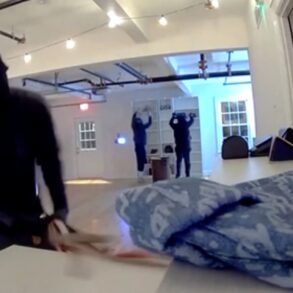The tropics of Australia’s Top End might seem a world away from the uber-stylish European fashion runways, but they are linked by a common item: luxury goods made from crocodile skin.
Key points:
- The federal government is launching a review of Australia’s crocodile farming industry
- The secretive industry is worth hundreds of millions of dollars and has links to high-end international fashion brands
- Animal rights groups have criticised the industry, but supporters say industry practices are humane
The high-end fashion industry is so important to northern Australia’s growing crocodile farming industry, our native reptiles are currently being killed at a younger age to cater for the trend of tiny handbags.
Crocodile leather from around the world is used by some of the world’s biggest luxury brands, including Hermes, Louis Vuitton and Saint Laurent.
Now, Australia’s crocodile farming industry is going under the microscope, with the federal government announcing a review of the 14-year-old code of practice.
The code oversees everything from egg collection, catching wild crocodiles, breeding in captivity, husbandry practices, and how these apex predators are killed.
“This is a really important industry and a really important source of jobs in a lot of remote communities, including for a lot of First Nations people,” Environment Minister Tanya Plibersek said.
“We have more science. We’ve got new techniques. It’s time to update the code of practice.”
What’s the industry’s background?
Crocodile farming in Australia started in the 1980s.
There are now at least 21 facilities across northern Australia, primarily in the Northern Territory and Queensland.
“They are farmed predominantly for the skins: beautiful hides that make beautiful leather products,” crocodile husbandry expert and Darwin-based farm consultant Sally Isberg said.
Seven exporters have been approved to send skins out of the country, and while the industry is cloaked in secrecy, luxury brands including Hermes are involved in the Australian industry.
In the Northern Territory, the way croc skins are harvested has changed a lot since the days of shooting saltwater crocodiles into near extinction.
“We currently have about 100,000 animals in our production system,” Dr Isberg said.
In the Territory, the boom in numbers has been expedited by taking crocodile eggs from the wild.
Crocodile egg collection can be treacherous work. Some people hang from helicopters on slings to get into clutches and the work is doubly dangerous due to the protective mother crocs nearby.
This facet of the commercial industry is already under scrutiny, after the star of a popular Netflix show died in west Arnhem Land in a helicopter crash last year, in circumstances currently going through the courts.
Once wild eggs are brought into farms, Dr Isberg said they’re kept at a specific temperature to ensure as many embryos survive as possible.
Young crocodiles are kept together and, depending on the size and type of the farm, go into solo pens as they get bigger.
Caring for them is very different to rearing livestock.
“Crocs need both land and water [and] they are fed red meat,” Dr Isberg said.
Crocodiles used to be grown to around 1.6 to 1.8 metres or around three and half years of age before harvest, Dr Isberg said.
However, their slaughter age has dropped to nearly two years old because of demand from the fashion industry.
“Each belly skin forms the gusset of the handbag,” she said.
“At the minute [what’s] in demand is smaller handbags. So therefore smaller skins.”
Industry, animal groups at loggerheads
Crocodiles can be stunned with electrical charge or given a range of chemicals including Valium, in order to control them, according to the industry’s code.
It recommends they be killed with a shot to the head or by severing the spinal cord and putting a rod up the back of the brain, in a process called “pithing”.
Dr Isberg said industry practice is to do both to be safe.
“We do not want any animal to be suffering,” she said.
However, animal welfare groups aren’t convinced.
Several years ago, activists released footage secretly recorded inside several farms.
While the slaughter process and conditions filmed appeared to be to code, activists argue the confronting reality of the industry is unpalatable.
As crocodiles get older they are more prone to fight, so in order to protect their valuable skins they can be held in isolation.
“They’re put into solitary confinement … for non-essential items like handbags and watch straps,” World Animal Protection’s (WAP) country director Ben Pearson said.
Mr Pearson said WAP advocates for better conditions for livestock animals. However, he can’t see a way to farm crocs that lets them exhibit their natural behaviour in the wild.
“Just because crocs are big, ugly dinosaurs doesn’t mean that they should be treated badly for a French luxury handbag.”
Jodi Truman, chief executive of the Crocodile Farmers Association of the NT, said the industry “supports independent audits to ensure humane treatment”.
“Animal rights activists have made clear that they are against all farms and the farming of all animals,” she said.
In the Northern Territory alone, the croc industry is worth more than $100 million a year. Many argue crocodile farming is linked to the rebound of the species because it has put a commercial price on their preservation.
“We need to look at the bigger picture here,” Dr Isberg said.
“It is a beautiful product … and the conservation and livelihood benefits that have come out of this just can’t be challenged.”
She said parts of the code that may need updating include putting in detail about how to give vaccines to crocodiles.
The review is expected to take 12 months and will be open to public comment, which means it could get held up if the debate gets controversial.








